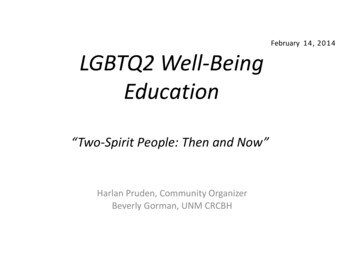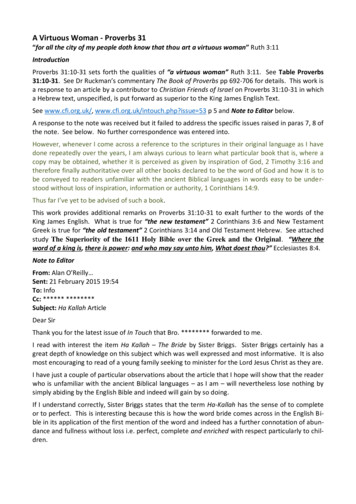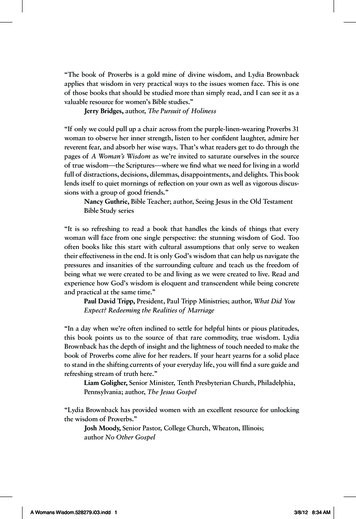
Transcription
Södertörn University College School of Life SciencesBachelor s Thesis 15 ECTS Environment and DevelopmentEducational Programme Spring semester 2011(Frivilligt: Programmet för xxx)Educate a woman –and you will educate an entirenation?– A comparative study between rural and urbanareas on the perception of education andempowerment of womenBy: Cecilia SundholmSupervisor: Vesa - Matti Loiske
Educate a woman- and you will educate an entire nation?Cecilia SundholmABSTRACTThis thesis aims to investigate if there are differences between men and women in rural and urbanareas on perception of women empowerment. The focus is on girls’ education and developmentin a post – colonial country. Semi structured, qualitative interviews were conducted in Babatidistrict, Tanzania in February 2011. In order to obtain as much useful information and data aspossible several research questions were focused on during the fieldwork. These were: What isthe perception on empowerment of women, according to local men and women in rural and urbanBabati? , How does a gender gap in school affect development, according to local men andwomen in rural and urban Babati? , Is the patriarchal heritage an obstacle for development andgender equality, according to local men and women in rural and urban Babati? , Why are urbanareas more equal than rural areas, according to local men and women in rural and urban Babati?The conclusion is that people in rural and urban areas are very similar in their opinions’ ofempowerment of women and education for girls. The traditional social and cultural structures areoften obstacles for development.Key words: Women empowerment, Development, Gender, Inequality, Schooling2
Educate a woman- and you will educate an entire nation?Cecilia Sundholm”Education is the most powerful weaponwhich you can use to change the world”– Nelson Mandela(van der Rheede 2010)3
Educate a woman- and you will educate an entire nation?Cecilia SundholmTABLE OF CONTENTS1. INTRODUCTION 51:1 BACKGROUND AND PURPOSE 51:2 THE UNIVERSAL DECLARATION OF HUMAN RIGHTS 61:3 RESEARCH QUESTIONS 72. THEORETICAL FRAMEWORK 82:1 WOMENS’ POLITICAL, SOCIAL AND ECONOMICAL ROLES 82:2 GENDER AND POSTCOLONIAL FEMINIST THEORY 92:3 WOMEN AND GENDER IN DEVELOPMENT THEORY 102:4 THE ISSUE OF GENDER AND EQUALITY 113. METHODOLOGY 123:1 PREPARATIONS TO FIELDWORK 123:2 CHOICE OF METHOD AND SAMPLING 123:3 INTERVIEW TECHNIQUE AND DATA COLLECTION 133:5 METHODOLOGICAL REFLECTIONS 144. RESULTS AND ANALYSIS 144:1 PERCEPTION ON EMPOWERMENT OF WOMEN 144:1:1 ANALYSIS 154:2 EDUCATION AND GENDER INEQUALITIES 164:2:1 ANALYSIS 184:3 MOTHER VS FATHER IN EDUCATING SKILLS? 194:3:1 ANALYSIS 204:4 SUPPORTIVE MEN 214:4:1 ANALYSIS 224:5 ARE URBAN AREAS MORE EQUAL? 234:5:1 ANALYSIS 246. SUMMARY OF CONCLUSIONS 247. LIST OF REFERENCES 268. APPENDIX 288:1 GENERAL INFORMATION ABOUT THE INFORMANTS 284
Educate a woman- and you will educate an entire nation?Cecilia Sundholm1. INTRODUCTIONThis chapter aims to explain some background information regarding education in Tanzania andgive an insight to the Universal Declaration of Human Rights and the Millennium DevelopmentGoals. Aim, problem statement and research questions are also included to give the reader anintroduction to the thesis.1:1 BACKGROUND AND PURPOSEEducational opportunities for people in poor countries is like a lottery depending on differentfactors such as where you live, how old you are, how much your parents can afford to pay butalso what sex you are. Out of the 113 million children in the world that have no access to primaryeducation, 60 % are girls. Inequality between the sexes is common and in the poor families inparticular, girls can expect to obtain far less education and schooling, if any, than boys. This isbecause the families cannot afford to pay the school fees or basic school supplies for all childrenand the boys tend to be favored. “ For poor families- and for those many families with a low cashincome- primary school is a luxury and secondary school is an impossibility” (Freedman 2004).During the colonial period in Tanzania many men left their families and homes to work on theplantations. The women alone then had to cope with all the agricultural workload on thecountryside formerly also shouldered by their men. Historically this has been an obstacle forwomens’ occupational choices and mobility because they were forced to stay on the same place.There is much evidence that efforts to educate girls and women generate increased developmentand modernization for a country or a nation. In Tanzania, as in many other countries in Africa,there is a patriarchal heritage. These old patriarchal traditions influence many aspects of the girls’lives and often has a negative impact on the opportunities given to the girls, for example in termsof education. According to statistics the number of boys and girls in Tanzania participating inschool is unequal.Gender statistics on educationin TanzaniaEquality in primary school0,99Number of girls/ boyEquality in secondary school0,82Number of girls/ boyEquality in gymnasium0,42Number of girls/ boy(FN 2011)5
Educate a woman- and you will educate an entire nation?Cecilia SundholmIn Tanzania boys are more likely to finish primary school than girls and they dominate the higherlevels of education in the country (FN 2011). Amongst important reasons behind thisphenomenon are; early marriage and teenage pregnancy, patriarchal heritage and cultural/traditional believes, poverty and child labor (LeMoyne 2008). One out of four girls in Tanzania isunder the age of 18 and still in school when she becomes pregnant and gives birth for the firsttime. Until recently pregnant girls weren’t allowed to continue school (Namfua 2009) and insteadobliged to stay at home taking care of household chores such as collecting water, preparing foodand taking care of children (LeMoyne 2008). After years of lobbying by for example UNICEF,the laws have changed and the girls that have become mothers can now find their way back intoschool and education (Namfua 2009).What do people living in a post- colonial country like Tanzania, think of development andwomen empowerment? The purpose of this thesis is to investigate weather mens’ and womens’perception on woman empowerment and education for girls, differ in rural and urban areas, inBabati district, Tanzania. This is important because gender and education are closely related todevelopment and globalization. The society is slowly changing and the peoples’ awarenesslikewise. Peoples’ perception on these issues is a vital factor to include in development strategiesand when trying to find out what causes an unequal society and what makes gender inequalitiesremain.1:2 THE UNIVERSAL DECLARATION OF HUMAN RIGHTSThe Universal Declaration of Human Rights was adopted and proclaimed on December 10, 1948by the General Assembly of the United Nations. It should be looked up on: ”as a commonstandard of achievement for all peoples and all nations, to the end that every individual and everyorgan of society, keeping this Declaration constantly in mind, shall strive by teaching andeducation to promote respect for these rights and freedoms and by progressive measures, nationaland international, to secure their universal and effective recognition and observance, both amongthe peoples of Member States themselves and among the peoples of territories under theirjurisdiction “ (UN 2010)1. In the 26th article in The Universal Declaration of Human Rights onecan read about the peoples’ right to education. It goes as follows:6
Educate a woman- and you will educate an entire nation? Cecilia Sundholm“Everyone has the right to education. Education shall be free, at least in the elementary andfundamental stages. Elementary education shall be compulsory. Technical and professionaleducation shall be made generally available and higher education shall be equally accessibleto all on the basis of merit”. “Education shall be directed to the full development of the human personality and to thestrengthening of respect for human rights and fundamental freedoms. It shall promoteunderstanding, tolerance and friendship among all nations, racial or religious groups, andshall further the activities of the United Nations for the maintenance of peace”. “Parents have a prior right to choose the kind of education that shall be given to theirchildren” (UN 2010)1.One of the Millennium Development Goal is: Promote gender equality and empower women.The target is to”Eliminate gender disparity in primary and secondary education, preferably by2005, and in all levels of education no later than 2015” (UN 2010)2. It was reaffirmed 2005 bythe United Nations Development Programme, UNDP. The terms “gender” and “gender equality”imply not only that men and women are included, but also the relationships between them.UNDP make efforts to improve women empowerment and promote gender equality and TheGender Equality Strategy 2008-2011 is an example of that. Because attention on womenempowerment and gender equality will bring increased action in other areas of work in TheMillennium Development Goal, this strategy is designed to complement and reinforce TheUNDPs’ Strategic Plan 2008-2011 (UNDP 2008).Another Millennium Development Goal is: Achieve universal primary education. The target isto “ensure that by 2015, children everywhere, boys and girls alike, will be able to complete afull course of primary schooling” (UN 2010)2. Between 2002 and 2006 an ambitiousprogramme of education reform was embarked in Tanzania, where 54 000 classrooms wereconstructed and 18 000 additional teachers were hired (UN 2010) 3.1:3 RESEARCH QUESTIONSTo obtain as much useful information and data as possible for the research project, these four (4)research questions were focused on:7
Educate a woman- and you will educate an entire nation?Cecilia Sundholm- What is the perception of empowerment of women, according to local men and women in ruraland urban Babati?- How does a gender gap in school affect development, according to local men and women inrural and urban Babati?- Is the patriarchal heritage an obstacle for development and gender equality, according to localmen and women in rural and urban Babati?- Why are urban areas more equal than rural areas, according to local men and women in ruraland urban Babati?2. THEORETICAL FRAMEWORKThis chapter aims to present different theoretical viewpoints which have been used in theresearch project.2:1 WOMENS’ POLITICAL, SOCIAL AND ECONOMICAL ROLESWhen discussing issues on development one of the most important aspects is empowering ofwomen and the positive consequences that it brings. Education and employment are twoexamples of what s included in this perspective, but also attitudes from the family or communitytowards women engaging, and the social conditions that might enable changes of these attitudes(Sen 1999 p. 287-288). Amartya Sen writes about women and their different roles in the society,in her work Development as freedom. According to him, if women are given the opportunitythey take the chance and most of the times do very well (Sen 1999 p. 283). The whole societywould benefit if women engaged in economical activities and that’s important for a country inorder to become part of globalization and development. One of the reasons why women areunderrepresented when it comes to daily economical activities is because the patriarchal heritagemakes them limited in their access to land and therefore can’t start business with help frombanks. There is also much evidence that educated women perform family planning and thereforetend not to get as many children as the uneducated women. That’s a perfect example of how thesociety will profit from women empowerment that leads to gender equality (Sen 1999 p. 284285). One of the most common meanings of women empowerment is womens’ growth incapacity to make choices, even though empowerment can also be discussed in general terms8
Educate a woman- and you will educate an entire nation?Cecilia SundholmArlesten & Leijon brings up arguments from writer Sylvia Chant, where she states that theempowerment of women is not dependent on womens’ access to material resources such aseducation. Instead she says that there need to be changes in the social, cultural and legalstructures of gender inequality in order to get a major impact. Education might help women tomake the right choices and contribute to bringing development forward but it is not a guaranteethat women with will gain power (Arlesten & Leijon 2010 p. 30).2:2 GENDER AND POSTCOLONIAL FEMINIST THEORYProfessor Chandra Talpade Mohanty is one of the leading postcolonial feminist theorists and inher classical work “Under Western Eyes: Feminist scholarship and colonial discourses” she talksabout the importance of taking into account that women in postcolonial countries have a differenthistorical and cultural background and context than the western women have, when discussingand analyzing gender relations. Furthermore she criticizes the western womens’ conception ofwestern gender relations as universal. Accoring to Mohanty “women in developing countries aredescribed merely as victims, or as women without agency and it is in terms of victimization thatthey are described in western feminist theory (Arlesten & Leijon 2010 p. 25).An expression widely used by postcolonial feminist theorists is “dual colonialism” or “doublecolonialism”. There are two different descriptions of the terms where the first one focuses one amale centered view of gender that the former colonialists had. They accentuated the mens’abilities to conquer and subordinate women and subjugate them into housekeepers and passivemothers. In a way, the western-centered gender relations were forced on the original inhabitantsby the colonialists and the internal social relations, where the native women had a high status,were torn down. The other description of “dual colonialism” focuses on how women wereneglected in postcolonial countries (Arlesten & Leijon 2010 p. 26). Ania Loomba argues inColonialism/Post colonialism that women in postcolonial countries rarely are described as mainsubjects in neither discourse of post colonialism or in feminism. She continues by stating thatwhen trying to understand colonialism and history, it’s of great necessity to bring postcolonialwomens’ experience as a main source (Loomba 2004 p. 140). Regarding gender relations innation building Arlesten & Leijon brings up the book “Gender and Nation”, written by professorNira Yuval- Davis who has studied gender and nation building within the field of politicalscience. Yuval – Davis argues that culturally and biologically rooted roles are given to men and9
Educate a woman- and you will educate an entire nation?Cecilia Sundholmwomen in the nation. These different roles include various responsibilities and they are importantfor the reproduction of the society. However, in terms of for example education, the roles orresponsibilities are not equally valued. Traditionally womens’ memberships in a nation are basedon their ability to secure a nations future by giving birth, while the mens’ role has been describedas citizenship givers to their offspring (Arlesten & Leijon 2010 p. 26).2:3 WOMEN AND GENDER IN DEVELOPMENT THEORYWomen and children make up the vast majority of those living in deprivation in the world andwhen talking about development, world poverty is an important aspect (Arlesten & Leijon 2010p. 30). Andersson argues that when increasing the level of educated girls, the end of povertystarts. Furthermore the incentives for a child to enroll in school increases in a family where themother has an education. Positive effects such as improved health, reduced fertility and familysize and more money to the household, are often connected with educated women. In the long runthese effects slow down population growth and thus, due to decreased fertility rates, affect theeconomical growth in a positive way (Andersson 2010 p. 8). In many poor countries a lot ofwomen are left in the rural areas when their men go to the urban areas for work. These womenusually don’t have money of their own nor access to their husbands economy. They are alsodeprived in areas such as opportunity to access education and this makes it difficult for them toobtain a higher income employment. They end up in the informal low-paying sectors withoutsocial security (Arlesten & Leijon 2010 p. 30). In the modern business sectors for example, thewomen are poorly represented, and low educational opportunities for women is seen as one of thereasons behind this. The educational gap between the sexes therefore enables even greatereconomic differences which eventually lead to economic stagnation in the society (Mårtensson2010 p. 10). Historically it has even been considered a waste to make efforts on educating women(Andersson 2010 p.8). Arlesten & Leijon talks about gender biases and they imply that becauseof the economical benefits a boy may supply to the family in the future, they tend to get morephysical attention, food, health care and education than girls. In societies where the parents andeven teachers value education for boys more than for girls, the gender biases are even greater(Andersson 2010 p. 8, 30).10
Educate a woman- and you will educate an entire nation?Cecilia Sundholm2:4 THE ISSUE OF GENDER AND EQUALITYThe term gender can be defined as “socially-ascribed meanings given to the categories man andwoman” (Mårtensson 2010 p. 31) and is an inevitable expression in discussions on the subject ofdevelopment. The definition refers to expectations and norms on men and women and the genderbased approach on development focuses on social roles of both male and female (Mårtensson2010 p. 31). Prior to the 1970s not much research had been carried out on the issue of gender inrelation to development, even though women in developing countries had been trying to addressthis issue since long before that. The general thought had been that there were no specificdifferences between men and women in poverty. Different kinds of research on this area has notonly brought up the negative effects of development on women but also shown what kind ofnegative impact this has on the whole nations’ development (Mårtensson 2010 p. 10). In order toachieve constant economic growth for a country, one of the most important things is to provideprimary schooling for all children. Therefore this is a huge challenge for the developing world intheir process towards globalization and modernization. Furthermore, education enables people towork themselves out of poverty not to mention the individual and national wellbeing thateducation of girls promotes. This is supported by the former South African president NelsonMandela in his famous quote: “Education is the most powerful weapon which you can use tochange the world” (Mårtensson 2010 p. 99). According to Mårtensson there are big differencesbetween boys and girls on education in Tanzania, and efforts are being made to improve access toprimary school for the most vulnerable ones, which are usually girls. Girls tend to drop out ofprimary school more frequently than boys and due to different reasons, such as for example earlypregnancy and early marriage, they miss essential schooling. One should also keep in mind thatin many poor countries the families’ economy is extremely marginalized and the parents have nochoice but to let the children drop out of school and instead contribute to the family income. Evenif the families’ income would increase in the long run it’s difficult to imply compulsory educationbecause the expenses would be higher and the family would face lower income in the short run(Andersson 2010 p. 6). Mårtensson argues that even though women in Tanzania represent 51 %of the population they don’t receive as much education as men and because the men aredominating the society the women are being socially disadvantaged. Social aspects and culturalcontexts should be given attention when investigating the importance of education for a nations’11
Educate a woman- and you will educate an entire nation?Cecilia Sundholmdevelopment. For example, even if a man and a woman have the same level of education, thepatriarchal heritage can still affect the women in a negative way (Mårtensson 2010 p. 10).3. METHODOLOGYThis chapter aims to explain and shed light on the inductive research method which consists ofqualitative semi structured interviews. Further, interview technique, data collection andmethodological reflections are discussed.3:1 PREPARATIONS TO FIELDWORKPrior to the excursion in February 2011 several weeks were spent on learning about Tanzania ingeneral and in particular subjects such as natural resources, economics, social and politicalstructures, etcetera. This was to give a contextual insight to the possible research subjectsavailable. Since issues on gender and development are always current in the developing world thesubject was decided to be; perceptions of women empowerment with focus on development andgirls’ education. Different research questions were chosen as starting point for the fieldwork.For the theoretical framework in this thesis, previous research concerning gender studies wasinvestigated and scientific essays and books have been used to gather sufficient secondarymaterial. Some of the information is applicable on Africa as a continent whilst some is specifiedfor Tanzania in particular.3:2 CHOICE OF METHOD AND SAMPLINGSince the aim of this essay was to find out about peoples’ perception on different subjects, thebest method to use was, qualitative, semi structured interviews. Any other method wouldn’t givesufficient data and information or give satisfying answers to the research questions. In order to beable to compare not only men and women, but also between rural and urban areas, differentpossible informants were considered. After discussing with a field assistant, four (4) differentlocations in Babati town and four (4) locations in rural Babati were chosen to get as goodspectrum of informants as possible and an optimal representation of each region. The rurallocations were sometimes hard to identify, since small villages close to Babati town could be12
Educate a woman- and you will educate an entire nation?Cecilia Sundholmconsidered both rural and urban. Because of lack of knowledge of the surroundings, the samplingprocess possibly didn’t always succeed and perhaps some of the rural interviewees were not ruralenough, in order to discover significant differences. This could have affected the results in a waythat the differences between rural and urban areas are less obvious.The traditional village of Endakiso was inhabited of Masais, and their answers were oftenpeculiar and difficult to grasp. Even though the data from these interviews is part of the researchstudy, it’s possible that they are not as reliable as the rest of the data. There is a chance that theMasais were heckling during the interviews. As a western female interviewing traditional peoplein a small village in Tanzania, they were given the opportunity to provoke the interviewer interms of startling comments. Perhaps they took that chance.Despite the planning it was hard to predict if there would be only a woman or a man or both,attending the interview. An open mind and flexible attitude is needed from the interviewerbecause the cultural differences sometimes make it complicated to predict the outcome of eachinterview. In order to obtain as much information as possible, everyone present at each interviewwas given the chance to answer questions.3:3 INTERVIEW TECHNIQUE AND DATA COLLECTIONSince the aim of the thesis was to find out about peoples’ perception of women empowerment,the optimum methodological approach was semi structured interviews. A quantitative methodwouldn’t give sufficient nor satisfying data. Several questions were prepared before hand and asthe first interviews had been conducted the questions were refined and improved, in order to suitthe informants and their expected level of awareness. During the interviews notes of theinformants’ answers were taken to each question in order to collect as much information aspossible.The advantage of semi structured interviews is that it does not limit the informant in his’ or hers’answers and it does not prevent explanations with more depth. The prepared questions can bereferred to as main questions, and in addition there is also room for open and spontaneousquestions. When finished one interview, at least one hour was spent on discussing it with the fieldassistant. This was to summarize the notes taken during the interview and to understand thecenter of each question in order to increase the reliability and validity of the data collected. Due13
Educate a woman- and you will educate an entire nation?Cecilia Sundholmto possible misinterpretations or miscommunication, potential mistakes are taken fullyresponsibility for.3:5 METHODOLOGICAL REFLECTIONSSince Swahili is one of the most common languages in Tanzania, the interviews conducted inBabati were performed with help of the field assistant. Each question was translated from Englishto Swahili and the answers, vice versa. In the Masai village, the informants spoke masai, alanguage of which the field assistant wasn’t familiar. Therefore an additional translator waspresent, and questions and answers were thus translated two times in each direction during theseinterviews. The possible consequences of these kinds of language obstacles are that some of theinformation, a specific meaning or emotion, gets lost or translated in a misinterpreting way. Itcreates an unnatural relation between the interviewer and the informant as a third part is present.This should be taken into consideration when analyzing the findings and the results, since eitherthe question could have been misunderstood, or the answers were possibly not fully translated orsummarized.Another matter or difficulty to be aware of is the presence of other people during the interviews.For example, if a man is present when interviewing a woman in a patriarchal community, shemight feel intimidated and therefore give answers that would be considered less peculiar andmore mainstream. That affects the final results and should also be taken into account in theanalysis.4. RESULTS AND ANALYSISThis chapter aims to present the results from the interviews and give an analysis withcorrelations to the theoretical framework. In order to create flow in the text the informants arecalled Uf1 and Um1 etcetera, where the letters and numbers stand for urban/rural area,female/male, and nr (of informant).4:1 PERCEPTION ON EMPOWERMENT OF WOMENWhen interviewing the people in rural and urban areas about their opinion on empowerment ofwomen the general answer was that it was something very positive for the society as a whole and14
Educate a woman- and you will educate an entire nation?Cecilia Sundholmimportant for development and modernization. Most of them included education for women inthe term empowerment.Uf1 mentioned the importance of education amongst elderly women because they can spread theknowledge to younger generations and by that bring good changes.Um1 said that empowerment of women means that they become stronger, they speak out moreand she will not be dependent on her husband. In fact they will be dependent on each other.Educated men think women empowerment is a good thing because she will earn her own money.In rural homes though, women can never become dominant, as men will feel inferior. Rm5 alsoclaimed that women become strong, independent and happier with money.Uf3s’ perception included organizing businesses and get capital and gain power. She added thatin rural areas people don’t know what empowerment is, there is only one tribe and they will notcome up with new ideas. They want to stay together in the tribe in their traditional beliefs.For Um2 the term meant opportunity to education and participation in the society. In the ruralarea the general explanation of the expression was more money to the household and goodchanges in the family and the society.Rm4s’ and Rf4s’ answers were very short and it seemed like they hardly understood the question.Rm4 answered empowerment is not important and the man decides everything and the womanshould obey. The man is always the head of the household and it is not an equal society. Rf4 saidthat empowerment of women is not important.4:1:1 ANALYSISEveryone, except Rm4 and Rf4, thought of women empowerment as something positive to seekfor and important for development. There where no
Amartya Sen writes about women and their different roles in the society, in her work Development as freedom. According to him, if women are given the opportunity- they take the chance and most of the times do very well (Sen 1999 p. 283). The whole society would benefit if women engaged in economical activities and that's important for a .










